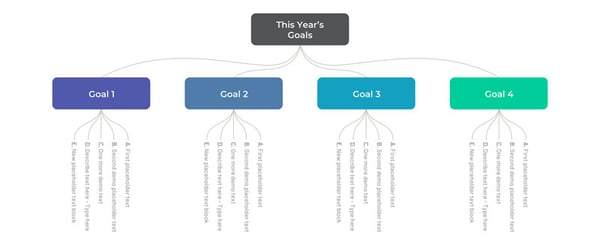Writing with AI - Learn more
Writing with AI - Learn more
Everything you need to know about better business writing in one place.
Business writing skills are crucial to your long-term success. Whether you're an admin or an executive, there is always room to improve, so along with our bedrock business writing course we've created this guide for you and your team improve business writing skills.
You'll learn about the foundational skills improve business writing: earn how to be concise, understand your audience, use active voice, avoid using jargon, and use correct punctuation and grammar. You'll find many practical tips, strategies, and examples in the guide.

Being successful in business requires skill with the written word. Additionally, conveying complex information in a logical and clear way is a major competitive advantage–no matter what industry you work in.
Enter business writing. If you or your team can communicate clearly at work, you will succeed. You will be able to communicate with colleagues and customers with ease, eliciting the action you want. You’ll be understood, which can save you time and energy.
Below is a complete guide to business writing—from a clear business writing definition to tips on how to hone your business writing skills.

“The difference between the right word and the almost right word is the difference between the lightning and the lightning bug.” - Mark Twain
Business writing is your opportunity to improve your business communications. It’s very pragmatic and is a type of writing that enables a reader to know or do something.
When done well, business writing flows up, down, laterally, internally to bosses and teammates, and externally to customers. Good business writing follows an optimal writing process.
This process:
Defines the reader and purpose.
Provides information that the defined reader needs.
Organizes information logically so it makes sense for the reader.
Helps you write in concise, clear, engaging language that is grammatically correct.

Business writing doesn’t focus on you as the writer. It focuses on the reader, helping them know or do something. You transform complex information into something that’s easy to understand. What you write is relevant to the reader.
This skill is the channel that transmits nearly all business work and insight and interaction. It is the lifeblood and foundation of strong businesses. Business writing also propels your career.

Better business writing has tangible benefits for both large and small organizations–no matter your formal job title. We’re all writers at work. Consider all the documents you might write in the office:
writing business emails and direct messages to keep work moving,
drafting memos and reports to inform team members, and
crafting business proposals, company brochures, statements of work, presentations, and other business documents for work both within and beyond your organization.
These documents require strong writing. Knowing how to approach writing makes you more productive. When you write persuasively, you can drive potential revenue. Or you can better connect with customers through sales and marketing materials.
In short, improving your business writing skills helps you become a more effective communicator. This skill has a ripple effect on your organization and career.

Provides the information needed to complete a task.
Documents created for reference or record.
Convey information and convince the reader of the value.
Used to quickly share everyday information.
Instructional business writing provides the reader with the information needed to complete a task. The task may need to be accomplished immediately or it may be for future reference.
Instructional documents break down a process into steps that the reader can understand. These steps must take the reader’s knowledge level of the topic into consideration.
A user manual or a guide focused on allowing the customer to use a product is one example of instructional writing.
A large majority of business writing is purely informational. Documents are created for reference or record. It might not be the most glamorous of styles, but the information in these documents must be accurate and consistent to help organizations run smoothly.
A business report is the most common type of informational writing, business reports communicate business and technical information, capture work completed, record incidents, finalize projects and recommendations, and act as an archive for organizations.
Persuasive writing is a common style for sales documents. The persuasive writing may be direct, with a focus on a specific item, or indirect, with a focus on developing the client relationship.
This type of writing has a two-fold goal: convey information and convince the reader that the presented information offers the best value. The message is designed to influence the reader’s decision.
An example of persuasive business writing includes business proposals: these documents outline an offer of a product or service to a specific potential client.
Transactional writing is used to progress general business operations and convey good and bad news. When you send everyday communications such as emails, you are completing transactional business writing.
Emails are a type of transactional writing. These documents are used to quickly communicate information between staff or clients in business activities. Transactional writing also includes official business letters, forms, and invoices.

Technical writing and business writing are two important and popular writing styles. Often used interchangeably, you might wonder: aren’t technical writing and business writing the same thing?
Not exactly. Granted, these two techniques are similar. Both styles are very reader-focused and overlap in their goal is to be accessible. They require concise language and specific word choices. Bulleted or numbered lists are often used for both styles to clearly present info. But one is not interchangeable with the other.
Business writing ranges from interpersonal to information to technical. Technical writing overlaps with business writing when a business person needs to convey technical information. In short, business writing = intention. Technical writing = instruction.
Tone is the key difference.
Business writing and technical writing differ in tone toward the target audience. The tone of business writing can vary, depending on the reader and the goal of the communication.
For example, a direct formal voice may be used for an internal memo. A professional but warm tone may be used for an email to a new client. You must write clearly and the message should be accessible, but the tone changes based on the audience. Good business writing clearly conveys both information and intent.
Technical writing rarely changes tone because its goal is to clearly and effectively explain something. Technical writing always has a neutral, competent tone. Unlike business writing, you’re not trying to persuade the reader to do something or develop a relationship. You’re using language to effectively communicate instructions to the target audience.
Business writing is the best technique for anything outside of communicating instructions. If your goal is to provide neutral directions, go with technical writing.

Getting started is usually the hardest part of writing. That’s why we recommend following a specific writing process.
No matter what you’re writing, this process helps you overcome writer’s block and gives you an exact framework for writing clearly and efficiently. Planning should take up 50% of your time. Here are the steps to follow when creating a business doc.

Always consider your audience and their needs. Even if you have multiple audiences (e.g., managers to customers), identify the most specific audience you can.
This approach helps you brainstorm content and eventually write a focused document with manageable topics and themes.

Now that you know your reader, determine what genre or medium you’ll use to deliver your message. What format makes the most sense for your audience? Here are a few delivery method examples:
Presentation
Formal report
Video call
Series of email attachments
If a written document makes the most sense for your reader, begin brainstorming what content the audience will need.

Now that you’ve analyzed your audience and determined the right format for your delivery, you can dig a little deeper and ask yourself more subtle considerations about these readers.
Because you’ve spent time thinking about your audience and the type of delivery that meets their needs and yours, you should have a much easier time giving shape to your ideas for this project.
Here are a couple of content generation strategies:
Outlining
Concept mapping
These strategies help your ideas take shape. Once you have your content completely planned out, you can then begin drafting your business document.

You’ve analyzed your audience. You’ve taken the time to generate content ideas and plan your content based on your reader’s needs. You are now ready to write the first draft of your document.
But what’s the most effective and efficient way to format your document? Every document is different, but similarities exist.

Business documents should be visually easy for your reader to digest. White space helps with this. It is the space between your words, paragraphs, and visual elements. White space makes your document easier to skim and read.
Add paragraph breaks every time you start a new thought to create white space. Another tip? Keep your paragraphs short. If your paragraphs are over seven lines (not sentences), the reader will typically skim over the content—all they see is a big block of text!

Lists such as numbered lists or bullets are one of the easiest ways to incorporate white space and make your business document format more effective. Readers can identify the items discussed, absorb content, and pay attention to what is important.
Use a numbered list if you are introducing a certain number of items, use a numbered list. If not, use bullets. Learn how to punctuate your bulleted lists here.

Break up content and guide the reader through the document by using headings. They serve as signposts, helping busy readers to skim through and come away with a decent understanding of the content. Here’s an example:
SALES STRATEGY FOR XYZ PRODUCT
Readers can see what information the section includes: a sales strategy.
The headings and subheadings hook their attention and encourage them to keep reading. Incorporate headings and subheadings into emails, reports, proposals, etc.

Don’t overwhelm your reader with a lot of visual elements such as adding a mix of bold, italics, and color throughout a document. While tempting to incorporate, too many different emphasis techniques cause the eye to bounce around the page.
Choose one design element for main points, such as bold, and another for sub-points, such as italics. Be consistent with these elements with your business document formatting to make it easier to skim for understanding.

Give your reader clarity when closing a document. For example, if your document needs a response, make sure your closing visually elicits the desired response.
This might be a “NEXT STEPS” heading before the last paragraph of an email. In a report, you might add a section heading such as “ACTION PLAN.” Visually highlight what you want your reader to do next.

You’re now equipped with an effective writing process. You also understand how to format your business document. Improve your business communications even more by following these 87 tips. We've identified 11 below.
We’ve already established that analyzing your audience and planning your content’s purpose is an important first step. However, it deserves re-emphasis. All of us by nature want to jump straight into drafting before planning.
The truth is that drafting gives us a (sometimes false) sense of accomplishment. And, drafting is easier than planning. Planning, however, is crucial to the writing process.
Often, the first sentence of a document or email is the hardest to write. But the great news is that you don’t have to start there.
Instead, look at your document sections. Write the one that is easiest or most interesting for you. Once you begin writing, the interconnectivity of thoughts will ignite, and the rest of the document will be easier to write.
Avoid flaunting big vocabulary in your business writing. Remember that you want to easily transmit ideas and information. Unless a big word will help you most effectively communicate your message, aim to use short words.
Blaise Pasqual stated,
"I apologize for the length of my letter. I did not have time to make it shorter."
No matter how much you want to edit while you draft, wait. It’s actually unproductive (and increases your writing time) when you try to fix grammar errors and sentence structure while drafting.
Instead, wait until you are completely done writing that first draft. We also recommend using a grammar tool like Grammarly to help you better catch grammar errors.
Have you ever noticed how companies often use the word “you” in marketing emails? “Get your discount today!” “You could save $X.” This is known as reader-focused wording and it can help increase reader engagement.
It’s the opposite of writer-focused wording which uses words like “we” and “our.” Be judicious with reader-focused wording as it can feel smarmy or similar to a marketing pitch. But it can be very effective if used judiciously.
Sound confident in your writing by applying two techniques:
Shorten your sentences.
Avoid the comma-and sentence structure (i.e. “, and”)
Try this technique with your own writing projects.
Confident writing sounds competent, calm, and assuring.
Grammar errors are part of writing. They’re also individual because every writer makes different errors. That said, below are the most common grammar errors we see in client writing:
fused or run-on sentences
sentence fragments
hyphen errors
me, myself, and I errors
introductory clause comma errors
Focus on what is incorrect to determine what are your most common errors and improve.
Professionals with fewer grammar errors achieve higher positions.
Business jargon. Corporate lingo. Buzz words. Whatever you call it, jargon creeps into business writing too often. There is even a book that addresses this problem, Why Business People Sound like Idiots. Here are a few common terms:
ASAP
Actionable
Due diligence
Raise the bar
Touch base
Table the conversation
Synergy
Business writers use jargon because everyone else incorporates it. Writers also believe that it sounds impressive and shows off knowledge of the latest industry terms. But the problem is that jargon is often difficult to understand. It’s easy for the reader to skim past, leaving them confused or ill-informed.
Prove your subject area expertise by cutting the jargon. Use terms that everyone can understand. Spell out acronyms. Your goal is audience comprehension–not to sound impressive.
Use Instructional Solutions Jargon Grader to identify
and remove business jargon in your own writing.
Delivering bad news via writing doesn’t have to be difficult. Depending on what you believe the reader’s response will be, choose a direct or indirect technique to deliver the message:
![]()
Jump straight into your bad news. Also, present a brief rationale with the bad news in the first paragraph to help your reader accept the decision.
![]()
Buffer your bad news indirectly if the message will cause your reader to emotionally disconnect before he or she reads fully. Do this by beginning with a neutral and relevant statement such as a compliment. You can then give the bad news with the rationale behind it.
Never apologize for a reasonable decision. Instead, focus on the facts.
As a general rule, use an active voice as much as you can in business writing. But there are times when passive voice makes more sense grammatically and stylistically.
Use passive voice for the following reasons:
To emphasize the result of an action or if the agent (person doing the action) is unknown or not important. This is super common in scientific or technical writing, the news, or historical accounts.
To describe a process. As you can imagine, this is commonly used in scientific and technical writing.
To use an impersonal or indirect tone, which suggests formality, impartiality, or objectivity. Passive voice makes sense in formal documents or announcements.
To avoid placing blame. Passive voice is sometimes used in insurance or banking because it doesn’t indicate WHO made a mistake.
To use a general subject. General subjects include people, you, they, we, everyone, someone, and anyone.

Communicating clearly through written text is a huge competitive advantage in any industry. Specifically, this skill helps individuals and teams succeed at work. A business writing course helps you take your writing to the next level.
At Instructional Solutions, we have nearly 25 years of teaching business writing courses. Below is a clear guide to help you choose the best business writing course for you and your team (and make the most of your financial investment!).
Specific writing goals help you choose a course that best fits your needs and the outcomes you want to achieve. Here are a few examples of common writing goals for individuals and businesses:
Common individual goals:
Significantly increase writing speed.
Convey complex information with more clarity.
Professionally disagree and write more persuasively.
Common organizational goals:
Reduce expensive communication mistakes.
Clearly convey insights and business opportunities.
Standardize the writing style across a division.
Once you’ve determined your own goals, identify your specific strengths and weaknesses under each goal.
Learn how to evaluate your course options – whether you are a company looking to provide a course to employees or an individual looking to take an online class.
First, outline your program objectives. Review the goals, weaknesses, and strengths of your team. Add even more details to create your project brief.
This project brief clarifies what you are looking for in a writing program. It also helps companies like Instructional Solutions understand your project needs.
Next, outline your “unique requirements.” These are elements that are distinct to your project. Identify these requirements to ensure that the course is built to support them.
Here are a few examples of unique course requirements we have helped design:
Industry-specific elements
Company writing models
Scalability of the course to multiple geographic areas
Integration with internal training programs
Specific reporting, tracking, and registration
Document compliance for regulatory board review
Coaching for major documents
Individual coaching and mentoring
Ongoing educational program
With your project brief and unique requirements in hand, determine course evaluation criteria to evaluate your training options.
Below is a helpful rubric we developed to help you successfully evaluate courses. This rubric highlights value, rather than price as the lowest cost option does not always offer the best value.
Use your unique evaluation criteria to review the course options. During this stage, talk with the course provider. Discuss details such as outcomes, timeline, and budget. Select the training provider who best fits your evaluation criteria.
Your selected course provider can now create the writing training program according to your project criteria. Ensure that this step is a collaborative process between your company and the provider.
Launch the program once the course development is complete. This means it’s time to enroll students and track results. Work with your provider to evaluate the program and participant progress periodically. Make updates if needed.
Review the course outline to make sure it addresses all writing weaknesses you’ve identified. If the course provider doesn’t offer an outline on the website, ask for one. Ensure that the course is fully comprehensive based on this outline.
Individual instructor feedback and interaction is one of the most important criteria for a writing course. As such, look for courses that provide this option. You’ll then receive individualized feedback on your business writing, which can help you improve significantly.
Evaluate the structure and quality of a course as much as you can, even without access to the full course. Thoroughly review the course outline. It’s also helpful to watch a sample lesson or view a video highlighting parts of the course.
Look at testimonials on the course provider’s website. Specifically, read testimonials from individuals who hold similar learning goals as you. Read the reviews – both good and bad. Read through both the best and worst scoring reviews.
If the provider also releases results from their post-course evaluations, review these as well. These evaluations are often less biased than reviews (reviews are normally written individuals that had a very good or very poor experience).
Contact the course provider to schedule a conversation about the course. Ask any remaining questions you have during the call. We recommend bringing a list of questions before the conversation.
Carefully review multiple courses to determine the right one for you. Courses normally address different learning objectives so look for the one that best matches your specific needs as a business writer.
Note: Please complete this form and tell us your writing requirements, challenges, and goals. We’ll then send you a course recommendation.
At Instructional Solutions, we offer many fully customizable courses for both groups and individuals – from practicum courses in proposal and report writing to our best-selling business writing techniques course.
Courses are structured similarly. However, the content for each course depends on the objectives.
View our business writing courses to determine the right selection for you, and decide which course best matches your specific goals.
The first thing you should look at when analyzing a course structure is the pedagogy (the theory and practice of how to best teach).
Instructional Solutions courses are based on Robert Gagne’s theory of adult education, designed for high-performance individuals in professional industries.
Specifically, look for courses that offer personalized instructor feedback about your writing exercises. Not many courses offer instructor feedback outside of mere editing of common grammar mistakes.
You want feedback that is holistic so you discover common pitfalls, your writing strengths, and learn the overall craft of writing. Ideally, this support is provided for the duration of your course. Most importantly, look for a course that provides feedback on your course goals and you as a business writer.

Business writing isn’t an optional skill. It’s the foundation of successful business operations and communications.
It also takes practice to hone; measuring, tracking, analyzing, and determining if changes need to be made on a weekly basis. But when you invest the time to develop these skills and become an effective communicator, your organization benefits–-both internally and externally with customers.
Get in-depth writing training with Instructional Solutions. Instructional Solutions has been delivering online business writing courses since 1998, following optimal online and adult learning principles. Click here to learn more.
Learn the best process for writing at work, and practice by constructing two different documents. Your instructor will provide detailed feedback on your actual writing.